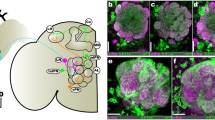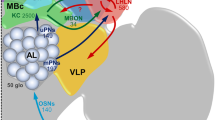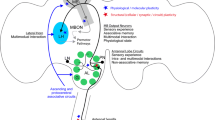Abstract
Biogenic amines play diverse roles in the development and modulation of invertebrate neurons and ultimately also, in the regulation of animal behaviour. Here we examine the contribution that analyses of antennal lobe neurons in vitro have made towards our understanding of the mechanisms through which dopamine and serotonin operate in primary olfactory centres of the brain of the moth, Manduca sexta and the honey bee, Apis mellifera. This chapter reviews evidence suggesting that these biogenic amines function as regulators of neuronal development and as mediators of cellular and behavioural plasticity, in part at least, through the modulation of K+ conductances in the cells. Insect neurons in vitro provide an excellent model for exploring basic principles of amine function and their impact on neuronal excitability.
Similar content being viewed by others
References
Baker K, Salkoff L (1990) The Drosophila shaker gene codes for a distinctive K+ current in a subset of neurons. Neuron 2:129–140
Beggs KT, Mercer AR (2009) Dopamine receptor activation by honey bee queen pheromone. Curr Biol 19:1206–1209
Beggs KT, Hamilton IS, Kurshan PT, Mustard JA, Mercer AR (2005) Characterization of a D2-like dopamine receptor (AmDOP3) in honey bee, Apis mellifera. Insect Biochem Mol Biol 35:873–882
Beggs KT, Tyndall J, Mercer AR (2011) Honeybee dopamine and octopamine receptors linked to intracellular calcium signalling have a close phylogenetic and pharmacological relationship. PLoS One 6(11):e26809
Blenau W, Baumann A (2001) Molecular and pharmacological properties of insect biogenic amine receptors: lessons from Drosophila melanogaster and Apis mellifera. Arch Insect Biochem Physiol 48:13–38
Blenau W, Thamm M (2011) Distribution of serotonin (5-HT) and its receptors in the insect brain with focus on the mushroom bodies. Lessons from Drosophila melanogaster and Apis mellifera. Arth Struct Dev 40:381–394
Blenau W, Erber J, Baumann A (1998) Characterization of a dopamine D1 receptor from Apis mellifera: cloning, functional expression, pharmacology, and mRNA localization in the brain. J Neurochem 70:15–23
Byerly L, Leung HT (1988) Ionic currents of Drosophila neurons in embryonic cultures. J Neurosci 8:4379–4393
Dacks AM, Dacks JB, Christensen TA, Nighorn AJ (2006) The cloning of one putative octopamine receptor and two putative serotonin receptors from the tobacco hawkmoth, Manduca sexta. Insect Biochem Mol Biol 36:741–744
Grohmann L, Blenau W, Erber J, Ebert PR, Strunker T et al (2003) Molecular and functional characterization of an octopamine receptor from honeybee (Apis mellifera) brain. J Neurochem 86:725–735
Hamill OP, Marty A, Neher E, Sakmann B, Sigworth RF (1981) Improved patch-clamp techniques for high-resolution current recording from cell-free membrane patches. Pflügers Arch 391:85–100
Hauser F, Cazzamali G, Williamson M, Blenau W, Grimmelikhuijzen CJP (2006) A review of neurohormone GPCRs present in the fruitfly Drosophila melanogaster and the honey bee Apis mellifera. Prog Neurobiol 80:1–19
Hayashi JH, Hildebrand JG (1990) Insect olfactory neurons in vitro: morphological and physiological characterization of cells from the developing antennal lobes of Manduca sexta. J Neurosci 10:848–859
Humphries MA, Mustard JA, Hunter SJ, Mercer AR, Ward V, Ebert PR (2003) Invertebrate D2 type dopamine receptor exhibits age-based plasticity of expression in the mushroom bodies of the honeybee brain. J Neurobiol 55:315–330
Katz LC, Shatz CJ (1996) Synaptic activity and the construction of cortical circuits. Science 274:1133–1138
Kent KS, Hoskins SG, Hildebrand JG (1987) A novel serotonin-immunoreactive neuron in the antennal lobe of the sphinx moth Manduca sexta persists throughout postembryonic life. J Neurobiol 18:451–465
Kirchhof BS, Homberg U, Mercer AR (1999) Development of dopamine-immunoreactive neurons associated with the antennal lobes of the honey bee, Apis mellifera. J Comp Neurol 411:643–653
Kloppenburg P, Heinbockel T (2000) 5-hydroxytryptamine modulates pheromone-evoked local field potentials in the macroglomerular complex of the sphinx moth Manduca sexta. J Exp Biol 203:1701–1709
Kloppenburg P, Hildebrand JG (1995) Neuromodulation by 5-hydroxytryptamine in the antennal lobe of the sphinx moth Manduca sexta. J Exp Biol 198:603–611
Kloppenburg P, Ferns D, Mercer AR (1999a) Serotonin enhances central olfactory neuron responses to female sex pheromone in the male sphinx moth Manduca sexta. J Neurosci 19:8172–8181
Kloppenburg P, Kirchhof BS, Mercer AR (1999b) Voltage-activated currents from adult honeybee (Apis mellifera) antennal motor neurons recorded in vitro and in situ. J Neurophysiol 81:39–48
Mercer AR, Hildebrand JG (2002a) Developmental changes in the electrophysiological properties and response characteristics of Manduca antennal-lobe neurons. J Neurophysiol 87:2650–2663
Mercer AR, Hildebrand JG (2002b) Developmental changes in the density of ionic currents in antennal-lobe neurons of the sphinx moth, Manduca sexta. J Neurophysiol 87:2664–2675
Mercer AR, Hayashi JH, Hildebrand JG (1995) Modulatory effects of 5-hydroxytryptamine on voltage-activated currents in cultured antennal lobe neurones of the sphinx moth Manduca sexta. J Exp Biol 198:613–627
Mercer AR, Kirchhof BS, Hildebrand JG (1996a) Enhancement by serotonin of the growth in vitro of antennal lobe neurons of the sphinx moth Manduca sexta. J Neurobiol 29:49–64
Mercer AR, Kloppenburg P, Hildebrand JG (1996b) Serotonin induced changes in the excitability of cultured antennal lobe neurons of the sphinx moth Manduca sexta. J Comp Physiol A 178:21–31
Mercer AR, Kloppenburg P, Hildebrand JG (2005) Plateau potentials in developing antennal-lobe neurons of the moth, Manduca sexta. J Neurophysiol 93:1949–1958
Mustard JA, Blenau W, Hamilton IS, Ward VK, Ebert PR, Mercer AR (2003) Analysis of two D1-like dopamine receptors from the honey bee Apis mellifera reveals agonist-independent activity. Mol Brain Res 113:67–77
Mustard JA, Beggs KT, Mercer AR (2005) Molecular biology of the invertebrate dopamine receptors. Arch Insect Biochem Physiol 59:103–117
Oland LA, Kirschenbaum SR, Pott WM, Mercer AR, Tolbert LP (1995) Development of an identified serotonergic neuron in the antennal lobe of the moth and effects of reduction in serotonin during construction of olfactory glomeruli. J Neurobiol 28:248–267
Oland LA, Pott WM, Bukhman G, Sun XJ, Tolbert LP (1996) Activity blockade does not prevent the construction of olfactory glomeruli in the moth Manduca sexta. Int J Dev Neurosci 14:983–996
Perk CG, Mercer AR (2006) Dopamine modulation of honey bee (Apis mellifera) antennal-lobe neurons. J Neurophysiol 95:1147–1157
Salkoff L, Baker K, Butler A, Covarrubias M, Pak MD, Wei A (1992) An essential ‘set’ of K+ channels conserved in flies, mice and humans. Trends Neurosci 15:161–166
Schäfer S, Rosenboom H, Menzel R (1994) Ionic currents of Kenyon cells from the mushroom body of the honeybee. J Neurosci 14:4600–4612
Schlenstedt J, Balfanz S, Baumann A, Blenau W (2006) Am5-HT7: molecular and pharmacological characterization of the first 5-HT receptor of the honeybee (Apis mellifera). J Neurochem 98:1985–1998
Spitzer NC (1994) Development of voltage-dependent and ligand-gated channels in excitable membranes. In: van Pelt J, Corner MA, Uylings HBM, Lopes da Silva FH (eds) Progress in brain research. Elsevier, Amsterdam, pp 169–179
Thamm M, Balfanz S, Scheiner R, Baumann A, Blenau W (2010) Characterization of the 5-HT1A receptor of the honeybee (Apis mellifera) and involvement of serotonin in phototactic behavior. Cell Mol Life Sci 67:2467–2479
Author information
Authors and Affiliations
Corresponding author
Rights and permissions
About this article
Cite this article
Ellen, C.W., Mercer, A.R. Modulatory actions of dopamine and serotonin on insect antennal lobe neurons: insights from studies in vitro. J Mol Hist 43, 401–404 (2012). https://doi.org/10.1007/s10735-012-9401-7
Received:
Accepted:
Published:
Issue Date:
DOI: https://doi.org/10.1007/s10735-012-9401-7




